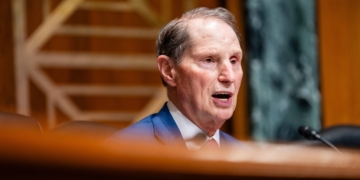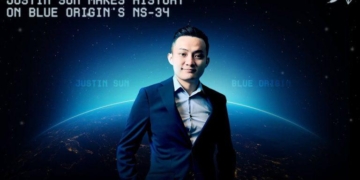
the US Department of Justice recently released what it described as raw footage from the night of Jeffrey Epstein’s death in 2019. When WIRED’s Dhruv Mehrotra went through the video’s metadata, he found that it had been, in fact, modified. In today’s episode, we dive into what Dhruv found and what it means.
Mentioned in this episode:
The FBI’s Jeffrey Epstein Prison Video Had Nearly 3 Minutes Cut Out, by Dhruv Mehrotra
Metadata Shows the FBI’s ‘Raw’ Jeffrey Epstein Prison Video Was Likely Modified, by Dhruv Mehrotra
You can follow Michael Calore on Bluesky at @snackfight, Lauren Goode on Bluesky at @laurengoode, and Katie Drummond on Bluesky at @katie-drummond. Write to us at uncannyvalley@wired.com.
How to Listen
You can always listen to this week’s podcast through the audio player on this page, but if you want to subscribe for free to get every episode, here’s how:
If you’re on an iPhone or iPad, open the app called Podcasts, or just tap this link. You can also download an app like Overcast or Pocket Casts and search for “uncanny valley.” We’re on Spotify too.
Transcript
Note: This is an automated transcript, which may contain errors.
Michael Calore: Hey everyone, this is Mike. Before we start, I want to take the chance to remind you that we want to hear from you. Do you have a question around AI, politics or privacy that has been on your mind, or just a topic that you wish we talked about on the show? If so, you can write to us at uncannyvalley@wired.com. And if you listen to and enjoy our episodes, please rate the show and leave a review on your podcast app of choice. It really helps other people find us. How is everybody doing this week?
Katie Drummond: I’m doing well. I am recovering from a vacation. I went to Detroit, Michigan, with my family. If you haven’t spent time in Detroit, I highly recommend it as a vacation destination, which may surprise you, depending on what kinds of vacations you like to take. But if you like to spend time in interesting cities with great food, you could spend some time in Detroit. It was awesome. So, I’m good. You come back from vacation and you’re like, you hate everything, and so I’m there, but I’ll get out of it. I’ll be fine.
Lauren Goode: Is it the purpose of a vacation though, to give you a little bit of relaxation and perspective so that you don’t hate everything?
Katie Drummond: That’s not the kind of vacation I take, Lauren. And-
Lauren Goode: OK. We need to get you to a spa.
Michael Calore: So, Detroit’s famous for its pizza, for its square pizza. How does it rate?
Lauren Goode: And its cars.
Michael Calore: Yeah, and its cars, but really, we’re more concerned about pizza.
Katie Drummond: Car, great, great roads. We had pizza twice. We had Detroit-style pizza night one. I mean, it’s delicious. I find it very heavy. I like to power-consume pizza, so I’m like 3, 4, 5 pieces of pizza. You can’t do that with this pizza. You know what I mean?
Michael Calore: Yes.
Katie Drummond: So I find that to be kind of a bummer, but it’s good, it’s just very heavy.
Lauren Goode: Katie, I have a very important question for you.
Katie Drummond: OK.
Lauren Goode: Do you eat your pizza with a fork?
Katie Drummond: No.
Lauren Goode: Thank God, OK.
Katie Drummond: Do you?
Lauren Goode: We have shaken it out. We can keep going.
Katie Drummond: Definitely not.
Lauren Goode: OK. No.
Katie Drummond: No chance.
Lauren Goode: No.
Katie Drummond: No, no chance.
Lauren Goode: As John Stewart once said, “You fold it and you eat it.”
Katie Drummond: Yes.
Dhruv Mehrotra: I generally fold mine into a small sphere and I just take the whole thing and put it right in my mouth.
Lauren Goode: I like that. Who is that voice who just joined us on this podcast?
Dhruv Mehrotra: It’s me, it’s Dhruv.
Lauren Goode: It’s our resident conspiracy theorist.
Michael Calore: This is WIRED’s Uncanny Valley, a show about the people, power, and influence of Silicon Valley. Today, the Jeffrey Epstein prison tapes. Likely, you have heard that the US Department of Justice and the Federal Bureau of Investigation has released nearly 11 hours of footage from a camera outside Epstein’s prison cell. The tape was from the night before he was found dead in his cell in 2019. When it was made public, we here at WIRED immediately analyzed the footage and found that it had been modified and that nearly three minutes seemed to have been cut from the feed. WIRED’s Dhruv Mehrotra and independent video forensic experts went through the footage’s metadata and found that it was likely modified using Adobe video editing software. This news has led to a deluge of speculation across the internet about what the edits to the footage mean, if anything. We’ll dive into what this means and why the Epstein case has proven to be a surprising fracturing point for Trump’s right-wing base. I’m Michael Calore, director of consumer tech and culture here at WIRED.
Lauren Goode: I’m Lauren Goode, I’m a senior correspondent at WIRED.
Katie Drummond: And I’m Katie Drummond, WIRED’s global editorial director.
Michael Calore: We are also incredibly lucky to have with us today our WIRED colleague who analyzed this recent released footage himself on the show. Please welcome Dhruv Mehrotra.
Dhruv Mehrotra: Hi, thanks for having me.
Michael Calore: OK, well, let’s start with why this video was released at all. It’s been almost six years since Jeffrey Epstein’s death, hasn’t it?
Lauren Goode: It has been. Jeffrey Epstein died in August of 2019, and pretty much from the start his death has fueled all of these conspiracy theories, partly because of his very high-profile associations. He was known to be friends with and business associates with and fraternize with celebrities and high-ranking officials, and even technologists. Also because of the explosive nature of the sex trafficking charges that Epstein was facing. So this all kind of had the elements that the internet needs to fuel a giant conspiracy theory. Now, one of the elements that fueled these theories was the fact that around the time when Epstein died by suicide, there was a malfunction in the cameras where he was being held, at the Metropolitan Correctional Center. About half their cameras weren’t working, none of them had a clear view of Epstein’s cell door. This has been previously reported by WIRED. And people have speculated that this is when he could have been killed, even though there’s no proof whatsoever of that.
Katie Drummond: And we’ll talk more about this later, but this issue is still alive and thriving online because Trump and his allies really capitalized on these conspiracy theories, all the theories about Epstein and what happened to him in that prison, on the campaign trail. So, Trump promised running his campaign for his second term that his administration would release allegedly explosive revelations about what really happened when Epstein died in custody in 2019, and Epstein’s supposed “client list.” So for months leading up to the joint memo that the DOJ and FBI published last week, Pam Bondi, the attorney general, had promised to release records related to Epstein. So, some of those have been slowly released, and this latest video that Dhruv has been reporting on is the latest piece of that rollout. So, that’s really how we got here.
Michael Calore: Yeah. Now, Dhruv, how did you go about analyzing the footage and how did you arrive at the conclusion that the video wasn’t actually raw footage as it was described?
Dhruv Mehrotra: Yeah, so on Monday last week, the DOJ and FBI released two videos, and there’s sort of almost immediate speculation about whether or not these videos were doctored. So I wanted to look at the files themselves and not the sort of video feed, but examine the metadata of the video just to figure out if there was anything in there that I could see that could lead to any clues about it being doctored. This is something I often do because as a journalist, you’re often vetting leaked or hacked documents to see if they were tampered with or something like that. So the first step was downloading both versions of the video that the FBI released, the so-called raw version, and then the enhanced one. They said that they had, alongside the raw video, they say they released a video that had some enhancements that helped their analysts come to the conclusion that Epstein in fact killed himself. So together, each video was about 21 gigabytes. I ran both of those files through this metadata analysis tool and I looked at what is called XMP metadata, which is basically data that’s embedded by software on a file when it’s touched, essentially. So looking at that data, it came became pretty clear pretty quickly actually, that it wasn’t a direct export from a surveillance system as the FBI kind of described it in their memo. Instead, the metadata showed that the video had been assembled from two distinct clips, two different MP4 files, using Adobe Premiere. It even names the files in the metadata. So those files are listed in a metadata section called ingredients, which is how Premiere tracks source materials that are used in a project. And in that metadata, we also saw that the project was saved multiple times and that there were internal markers and comments left behind, likely used to flag activity during the review. So, all of this is sort of standard for edited video workflows, but it really contradicts the DOJ’s description of this as raw video. It’s not raw, it was manually edited and stitched together as a composite of two different video recordings.
Katie Drummond: It’s really wild to me in the context of unforced error. And how did no one in the DOJ or the FBI think, oh, maybe someone is going to look at the metadata? That’s one very obvious question, but then Dhruv, on a more sort of technical note, if someone has that foresight, if they think, OK, there will be metadata attached to these files, dah, dah, dah, dah, dah, someone could look at it, what are their options? Is there anything that you can do to scrub the metadata on video files like these, that potentially they could have done if they didn’t want some annoying reporter like you to go looking or poking around to see sort of what was in there?
Lauren Goode: She says that with maximum affection, Dhruv.
Katie Drummond: Of course. You’re not annoying to me, but you’re definitely annoying to them right now.
Dhruv Mehrotra: Yeah, I definitely get the sense that I’m very annoying to them right now. Yes, there are plenty of things that you can do to scrub metadata from a file before you upload it somewhere for someone to download and inspect. In fact, that’s sort of standard practice across the internet. I think most social media platforms, when you upload a photo from your iPhone or from your Android, it’ll scrub the metadata before it puts it up on Instagram or whatever. And it’s also standard practice for reporters to do that if we receive documents and we want to publish parts of the documents but not the entirety of them, we’ll scrub metadata to make sure that nothing in the file can lead back to our sourcing. So it’s standard practice and frankly, kind of surprising that the FBI didn’t do it. With that said though, it also forensically, you could see a world where you would want to keep the metadata in to show the public, or show a judge, show attorneys exactly who touched a file before it was released publicly. So that way there was a sort of trail of custody to make sure that the evidence hadn’t been tampered with. So, I can see it working both ways, but it seems like that’s just neither of those cases is what happened here.
Michael Calore: Do we know who touched this file?
Dhruv Mehrotra: We do, sort of. We know that this file was edited by a Windows user with the name MJ Cole. I think that’s a partial username, not a full username, but someone named MJ Cole, and perhaps a longer last name, I suppose.
Michael Calore: Right.
Lauren Goode: And we know, we have this name because this is the person who logged into the machine? This is the name attached to the Adobe license? How do we know this is actually the person? Because it could have just been another video editor logged into someone else’s machine.
Dhruv Mehrotra: No, that’s a good point. I should say that we know that the user account that opened the file and edited it was MJ Cole. Whether or not someone else was using that Windows computer at the time, that’s impossible for me to say with the metadata alone.
Lauren Goode: Dhruv, I’m glad you mentioned that about the workflow of video journalists because a very long time ago I was a video journalist and I can attest to having exported the same video file multiple times from Apple Final Cut Pro or Adobe Premiere, with absolutely zero intention of manipulating the video content, just maybe trimming or making one small change in exporting the files. In this instance, what’s notable about these file exports that could lead people to potentially believe that they were manipulated with mal-intent?
Dhruv Mehrotra: Yeah, I mean, I think at first I was just trying to confirm that any kind of editing software had been used. Right? I think if you are just trying to export some proprietary surveillance CCTV footage to an MP4, there are lighter weight tools than Adobe Premiere, which has all of these actually additional AI based editing features to them. Right? And I think speaking to forensic experts, that was one of the big questions they had was like, look, if you’re just going to export a video, why use Premiere? So that was one big question I had, right? But after getting a few tips, I also noticed more odd things in the metadata outside of them just using Adobe Premiere. Right? Specifically, there were timestamps in the source video clips that were composited to form the final video. The first source file is listed as being four hours and 19 minutes long, but the video that was actually used in the final output was only four hours and 16 minutes long, which means that nearly three minutes were cut from this original clip that was put into the video, which is, that’s a sign of an edit, not just an export. When I spoke to Hany Farid, he’s a UC Berkeley professor who focuses on digital forensics and frankly testifies in court often about manipulated media, he pointed out very quickly just watching the video that the aspect ratio of the footage changed throughout the video. So I think it was pretty widely reported when the video first came out that there was a missing minute. Attorney General Pam Bondi kind of attributed that missing minute to just routine turnover in surveillance footage and sort of just wrote it off as nothing to really be concerned about. But what’s interesting about that is after that jump, the aspect ratio changes. You can see a little toolbar in the top right of the screen. So this isn’t a raw export of surveillance footage, something else is kind of happening here. And we just don’t know enough about the process the DOJ and the FBI used to analyze these videos to really say much.
Katie Drummond: And obviously, we have plenty of sort of careful language in these stories that you’ve published Dhruv, but none of this proves that the videos were edited with the intention of deceiving people, of hiding something. Right? There are some pretty boring explanations for all of this, although I will say they’re not exactly doing themselves any favors at all, which is so painful to witness because these do feel like a lot of real amateur hour unforced errors if in fact, this is all very banal stuff.
Dhruv Mehrotra: Yeah. I mean, look, the goal of the story wasn’t to prove or disprove a conspiracy. It was really to independently verify what the DOJ and FBI said about the footage, which is that it was a raw surveillance video. And based on the metadata, that’s just not accurate. It was processed, reviewed, and assembled from multiple clips, and that doesn’t mean that anything nefarious happened, right? There are plenty of non-sinister reasons that footage might have been reviewed or exported that way, especially if it’s being prepared for public release. But when the DOJ labels something as raw and then doesn’t disclose that it’s been edited or stitched together, that opens the door to a lot of suspicion. And in a case like this, a high-profile case where there already is a ton of suspicion and conspiracy around Epstein and his life, his death, I think any ambiguity will just lead to more conspiracies.
Michael Calore: Right, and a lot of people online have taken this as confirmation of a cover-up. Did you anticipate that when you were putting the story out?
Dhruv Mehrotra: Yeah, and I think to Katie’s point about all the careful language in the story, we fully expected people to run with this story and to use it to fit whatever flavor of Epstein conspiracy they subscribe to, which is part of the reason that we wanted to lay out the facts very, very clearly. Because if you don’t explain what the metadata actually means, someone might not do it responsibly, right? So we wanted to be very careful with how we presented the findings.
Katie Drummond: Yeah, and I think I will pat everybody involved in this reporting on the back, I’m very proud to have published it. I wouldn’t think twice or blink at the idea of publishing the work. It was very carefully done and very sort of clearly explained and articulated in both stories. I think there is this sort of interesting feeling as an editor, and I think as a reporter, when you publish a story like this and you know, you have a fairly good sense of how the internet will respond to it, which is, this is going to kick up a lot of dust. There’s going to be a lot of really problematic conspiratorial conversation about this work, but the work is the work. It’s true, it’s accurate, it’s carefully vetted, it’s carefully written. And ultimately, you have an obligation to publish it, even if you know that some very special groups of people on Reddit and elsewhere on the internet are going to absolutely lose their minds. I mean, that is just, you can know it and you publish anyway, and I think this is a really good example of that kind of situation for us.
Dhruv Mehrotra: Well, I think it’s also important to point out here is we presented the facts to the DOJ and to the FBI and gave them the opportunity to respond and to clarify what exactly happened here. Right? And neither agency did. The DOJ referred us to the FBI, the FBI referred us back to the DOJ. We haven’t had any clarity on what the process was for compiling this video.
Lauren Goode: Dhruv, if I’m understanding correctly, after WIRED ran its story last Friday about the evidence that showed the video was edited. A couple days later, attorney General Bondi sort of explained that by saying that there is a flaw in the surveillance system’s daily cycle at Metropolitan Correctional Center. She said that one minute is missing from every night’s recording, which seems like an entirely plausible explanation. But unfortunately, they’ve already sort of shot themselves in the foot by claiming the footage was raw when it wasn’t. And now, there’s this new report you just published in WIRED saying actually, there was this three minute discrepancy here too. This is really just going to fuel even more conspiracy theories, right?
Dhruv Mehrotra: Yeah. So, just to backtrack a bit on that, is that when Attorney General Bondi made the statement about the missing minute, that wasn’t in response to WIRED’s reporting, that was in response to just a very obvious missing minute that the internet found and immediately latched onto and a reporter asked her a question about it. But what we found today does sort of call into question the explanation of the missing minute. What we found is that the first clip that comprises the full “unedited, raw surveillance video,” which is made up of two clips, that first clip, the total length of the clip is four hours and 19 minutes, but the final output only used four hours and 16 minutes of it. So there’s three minutes of missing footage at the end of that first clip. And it just so turns out that that edit was made basically the frame before the missing minute that Pam Bondi described occurred. Right? So we don’t know what’s on that remaining three minutes, but maybe it’s the missing minute, maybe it’s not. The problem is that the DOJ hasn’t told us anything.
Michael Calore: So if I’m hearing you correctly, the first clip extends until after midnight, and the second clip starts at midnight. And when they made the edit, they edited it so that the first clip ends at 11:59. So they introduced the missing minute, possibly, or they had an opportunity to cut at midnight and not release a video that had a missing minute, and they did not take that opportunity?
Dhruv Mehrotra: Yeah, I don’t want to dive into conspiracy here. So we don’t know what’s in the last three minutes of the clip that was cut. Right? We don’t know if it included footage into August 10th the following day, or if it cut after the missing minute and it just was dead air or something that needed to be cut out because it was some artifact of an old surveillance camera. We just don’t know, and these are all questions we brought to the DOJ and they didn’t respond.
Michael Calore: I see.
Lauren Goode: Dhruv, what has been the most surprising reaction to this or response to this that you’ve gotten on the internet since your stories have been published? Are all the conspiracy folks flooding your Signal now?
Dhruv Mehrotra: Yeah, I have a very active inbox on both Signal and email.
Lauren Goode: Oh, God.
Dhruv Mehrotra: And to be fair to everyone who emails me, there’s plenty of actually really good tips in there. In fact, this second story about the three-minute cut, that started from a tip. Someone said, “You should check out this aspect of the metadata.” So there’s plenty of really good stuff in my inbox, but there’s also a ton of conspiracies, and that’s what happens when you report about Epstein. And I think in all seriousness though, the volume of responses here kind of shows how little trust there is in institutions right now. Right? The vacuum gets filled pretty fast when there’s any kind of whiff of inconsistency in a case like Epstein’s, where people already think the story doesn’t quite add up.
Michael Calore: Right. Well, Dhruv, thank you so much for coming on and telling us about your reporting on this story.
Dhruv Mehrotra: All right, well, thanks for having me.
Michael Calore: We’re going to take a quick break, but when we’re back, we’ll talk about why the Epstein prison tapes have become a wedge issue for one group in particular, Trump supporters. So at the beginning of our conversation, we were talking about why the Epstein case had become this infinite source for conspiracy theories, but who is most invested in these conspiracy theories at this moment?
Katie Drummond: Oh, well, surprise, surprise, it is a significant portion of the right-wing base. So, led by key figures in the MAGA movement, people have been pushing these unsubstantiated claims that Epstein was murdered and that liberal “deep state actors” in the government did it essentially to hide his client’s names and all of their awful criminal activities. So I’m talking about people like Steve Bannon, Laura Loomer. Laura, thank you for sharing our reporting on social, we really appreciate the traffic bump that we got from that. So it’s the usual suspects. It’s probably who you would expect if you pay much attention to MAGA world. But there was this shift last week, when the DOJ and the FBI released the memo announcing that these videos would be released, and this one video in particular. The memo also concluded that their investigation into the Epstein case was officially closed and that no foul play was found. That memo also stated that the Epstein client list that Bondi had said was on her desk in February, didn’t actually exist. Very special. So, as you can probably guess, MAGA figures did not take kindly to those announcements. And Trump supporters had been expecting some kind of breakthrough, some kind of conspiratorial revelation in this saga. And so they really created the fumes for this conspiracy theory that now they can’t put out and is really spiraling out of control.
Michael Calore: And it’s interesting, because the MAGA world and the Trump brand really just thrives in conspiracy theories, and it has for a long time. They put into question President Obama’s citizenship, there was the whole pizza-gate fiasco, there was the whole theory that the 2020 election had been stolen. The list goes on. So, what went wrong, if you will, with the strategy of doubling down on conspiracy theories, in this case?
Lauren Goode: Yeah, this is a good question. Our colleague, David Gilbert has been doing a lot of reporting on this, also on WIRED.com. And what’s interesting is the uproar around Epstein and the fact that folks within the MAGA sort of faction are starting to turn on Trump, is really part of a death by 1,000 cuts here. There are all kinds of groups that are mad at him for different things right now, and it’s being led by different powerful right-wing figures as Katie pointed out. There’s Tucker Carlson, the former Fox News host, who was mad about the bombing of Iran. For Loomer, she’s a noted conspiracy theorist, it was Trump’s acceptance of a luxury plane from Qatar. Ben Shapiro was mad about tariffs. Joe Rogan, mad about ICE raids targeting non-criminal migrant workers. Elon Musk eventually got mad at Trump, right? He was his buddy-in-chief, recently left his role in D.C. as a special government employee and has been railing about the big beautiful bill on mine. So there are all these different high-profile folks who have been turning on Trump lately, and I think Trump has been upsetting more and more of his base, bit by bit. The Epstein saga touches a slightly different nerve, too because it is centered on accusations of pedophilia. And also, the boogeymen in this case for so long were the Democratic Party. Trump’s space was extremely riled up over it. Trump himself used to say that Epstein’s death was a cover-up job. Now it turns out that the MAGA folks have reason to believe, whether it’s a good reason, whether it’s a valid reason, but reason to believe that Trump himself could possibly be one of the figures in this so-called list.
Katie Drummond: Oh, it’s exhausting just thinking about it. It is also worth remembering, and I think reinforcing that these conspiracy theories aren’t random. They’re not sort of just being pulled out of thin air. A lot of them coalesce actually around one very special conspiracy. QAnon, You may or may not remember it. I mean, that was all the rage a few years ago. But this idea that QAnon championed, and there are still certainly QAnon adherents out there, that there is this sort of shadowy cabal of government elites. They’re working to cover up a global child sex trafficking operation. This was really foundational stuff for the MAGA movement. And QAnon borrowed from a long tradition of conspiracy theory movements in the US, think about Satanic panic from the ’80s, and put those on steroids. So certainly, none of this started with the Trump Administration, I don’t think it will stop with the Trump Administration. It really has become sort of embedded into the way of thinking and sort of navigating the world and seeing the world for an unfortunate number of people out there, quite honestly.
Michael Calore: I’m curious to know what you both think this rift among the right-wing base and the overall proliferation of conspiracy theories means for the political and technological landscape of the country. Conspiracy theories aren’t new, they’re not going anywhere, but what does that mean in a world where tech companies are intrinsically more embedded in the political sphere? How much responsibility do these companies hold for the spread of these theories?
Lauren Goode: I would really love to hear your guys’ thoughts on this because the question of, how responsible are the tech companies, is just something that comes up literally every day for us, for the ills of society. You mentioned conspiracy theories are not new. They’re not. They take hold in a different way though when they’re on the internet, because they spread more rapidly and because of the way algorithms can surface different content more than others. Also in the United States, we have this legal framework that actually shields internet platforms for being responsible for some of the bad content, it’s section 230. And of course, a lot of the tech companies themselves don’t love the fact that they may have to invest in robust content moderation systems because they look at those things as a cost center. They don’t look at it as an area of growth for them, because you’re actually sort of restricting in some ways what people can put on the platforms. So when things go well or are relatively pleasant in an app, because a company has put the cost into decent content moderation, no one complains, everything seems relatively peachy. When all hell breaks loose, that’s when everyone says, “Wait, who’s moderating the content?” And that’s sort of where we are perpetually living now. And I think unfortunately, the best chance we have in the short term of curbing conspiracy theories is probably trying to educate the public so that people can better understand what is real on the internet and what is not. I hate saying that, because it just puts so much more onus on the public, on the individual consumer to figure out what’s real and what’s not. But I think barring any regulation in the short term, barring any major changes to the way these platforms work, I think that’s the nearest and best bet. That’s what I do think internet platforms should be responsible about and possibly for the algorithms, because you don’t have to amplify the Jeffrey Epstein conspiracy theories on X or whatever it is that’s bubbling to the surface.
Katie Drummond: Yeah, I mean, you don’t have to amplify it. I mean, you can also make deliberate choices to bury it. And I think Lauren, I wish I had a lot to add to that, but I just think that you’re totally right. I mean, this is at the end of the day, conspiracy theories and conspiracy theorists and miss and disinformation are not going anywhere. Right? They are here to stay. It’s a regulation question. It’s, what are we allowing people to see on the internet? What are these technology companies facilitating with their algorithms, with the way they run their companies? And as of now, they are by and large not held accountable for that at all. And it’s really hard. I try to be relatively optimistic about things, I try to always have some solution in my head. This is one where there’s a futility to it as AI and sort of more and more realistic looking nonsense and often dangerous nonsense sort of floods these platforms. It’s very hard to see a solution short of really aggressive regulation. That’s my 2 cents. And I think education, look, I think it’s a nice idea. I think if we are trying to educate and empower people who are already down the Epstein rabbit hole, for example, among the many other rabbit holes they could already be down. There’s a futility to that, it feels like a lost cause, almost like a lost couple of generations of people in some cases and that’s very sad. So I don’t have a solution, but it is a regulation issue. And again, in this current moment in time, it’s hard to imagine any of that regulation actually coming to the fore.
Michael Calore: Yeah, and I mean, to add to that, so many of the platforms are now turning to AI as a solution for moderation, right? They’re building these AI tools that are going to be moderating in place of humans who might be able to make those decisions about choosing not to amplify things that are possibly harmful or intentionally harmful. And I don’t know, the sick part of me is looking forward to the future where the AI tool that spends so much time moderating all of these conspiracy theories starts to generate its own conspiracy theories. And then the next big conspiracy theory is one that was born of AI and we just won’t know.
Lauren Goode: We’re probably not that far from that. I think we’re about two weeks from that.
Katie Drummond: I can see that happening, yeah. Coming up soon on WIRED.com.
Michael Calore: All right, let’s take another break and we’ll come back with the recommendations. All right. Well, thanks to both of you for a great conversation today and thanks in absentia to Dhruv. Before we shift gears to our own personal recommendations, we have an update on our end. This is sadly Katie’s last week on this roundtable edition of this show with me and Lauren. Lauren and I will still be here every Thursday, but it’ll just be the two of us for a while. And Katie, you will be missed.
Katie Drummond: It was short, it was sweet, and I’ve had a fantastic time and I just want everyone to know that I am not going too far. I have something new coming, something new and exciting on this very feed, spoiler alert, that I’m very excited to launch in the very near future. And I’m sure I will be back. I think you guys run a great show, just the two of you, but I would love to make a guest appearance every once in a while.
Lauren Goode: Oh, we would love that. I was already thinking, when can we invite Katie back?
Katie Drummond: Oh, that’s so nice.
Lauren Goode: We’re basically building in Marvel Cinematic Universe here of WIRED reporters and editors. So we still have the Uncanny Valley news episode featuring Zoë Schiffer and other WIRED colleagues, that publishes later in the week. We have our roundtable, of course, Uncanny Valley on Thursdays, and now we have this new project coming from Katie. You’ll see us moving around a bit, but don’t go anywhere, stay subscribed to the feed. Tell us what you want to hear more about, leave us reviews, and we’re very excited for you, Katie.
Katie Drummond: I’m very excited for all of us.
Michael Calore: All right, well, on a happier note, I know we all have really good recommendations because we’ve all been away on vacation for a week and we’ve had a long time to think about it. So Katie, you go first. What’s your recommendation?
Katie Drummond: Oh, no. Oh my God, I have one. This is so bad, this is classic Drummond, this is so bad. I’m watching this show on Bravo, surprise, surprise, called Next Gen NYC. Has anyone heard of this? Have you guys heard of this?
Michael Calore: No.
Katie Drummond: Well, listen up, listen up. This is like if the Real Housewives franchise featured 22-year olds, that’s what this show is.
Lauren Goode: So it’s Girls?
Katie Drummond: No, but it’s a reality show, Lauren, and it’s about a group of young people living in New York City. And the best part, several of them are the children of Real Housewives OG.
Michael Calore: Wow.
Lauren Goode: Wow.
Katie Drummond: It’s fantastic. It is the best reality TV I have seen in at least eight to 12 weeks. It’s very good, it’s very good. I joined the Reddit community, so I’ve been reading up, I’ve been following the discourse. I mean, look, I was on vacation, but also, would I watch this during my regular work life? Absolutely. It’s very good, and if anyone needs to just unplug, watch the dumbest possible thing, it’s really good. I recommend it. I’m sorry that I don’t have recommendations other than bad TV and butter, but that’s just my life.
Michael Calore: Is this why you’re such a big fan of reality television, because it’s your method of unplugging and just watching the dumbest thing possible?
Katie Drummond: Yeah. I found maybe six or seven years ago, maybe it was during the first Trump Administration and I was obviously covering it as a journalist, as we all were, living through it, I developed this inability to watch smart, serious TV. I used to watch, I mean, my husband and I watched Sons of Anarchy, we watched Mad Men, Breaking Bad, all of those sort of 2010 classics. We watched very serious TV, and then something happened, something changed in me, and I am only able to watch the dumbest, most mindless possible TV. And I think it’s just like I need to fully disconnect from anything that’s going to make me feel feelings because looking at everything happening in this country and in the world and the stress of the job, and you feel a lot of feelings. And it’s nice to just watch Brooks and Ava and Charlie and all of their other friends at the bar arguing about how Ava said that Adriana couldn’t possibly launch her own fashion line. That’s just nice. That’s a nice problem for them to have.
Michael Calore: Lauren, what is your recommendation?
Lauren Goode: My recommendation, I have two. One is the Planet Money. Well, first of all, just Planet Money, the podcast by NPR, fantastic. I am a subscriber. They did an episode recently on the Big Beautiful Bill, it was one of the best breakdowns I’d heard of what it actually contains, what’s actually going to be happening to Medicaid. I thought it was really informative. Listened to it when I was at the gym because I’m a nerd like that. Check that out. My other recommendation, which is more in the vein of what Katie is saying, like unplug, give your mind a break. Go to the movies.
Michael Calore: Go to the movies.
Lauren Goode: Just go to the movies.
Katie Drummond: I like that.
Michael Calore: This is the worst time of year to go to the movies.
Lauren Goode: No, it’s the best time of the year because air conditioning and comfy seats.
Michael Calore: Yeah, but it’s-
Katie Drummond: I’m with Lauren, that’s great advice.
Lauren Goode: No, I’ve been three times this year and every time, very last minute. A friend invited me last minute to go see the 40th anniversary of Goonies that was playing downtown. We went, it was fantastic. I was hanging out with friends one night and we said, “Let’s go see Sinners.” It was playing right across the street, fantastic. The theater was practically empty, it was glorious. The movie itself, actually, check out our friends, Critics at Large, New Yorker pod. They had some thoughts on the Materialists, so I’m going to toss it to them, but it was great. I was like, I need to go to the movies more.
Michael Calore: Oh, for sure.
Lauren Goode: What’s your recommendation, Mike?
Michael Calore: I’m going to recommend a book, and this is a book that I read over 4th of July weekend. It’s called, I Cheerfully Refuse by Leif Enger. I believe this is Leif Enger’s fourth novel. He’s a bestseller, you may have heard of his name before. This is his new book, it is dystopian fiction. It depicts a world a few decades from now in which society has crumbled in a way that feels very recognizable and familiar, a bit like a more dangerous and uncertain version of today. The entire economy is controlled by a handful of super rich elites. The education system is crumbled, most Americans are proudly illiterate. We have a proudly illiterate president in this book. Satellite communications have been enshittified, are totally unreliable, GPS doesn’t work anymore. It is just like an eroded version of the world that we live in, and it’s really starkly rendered. We drop into this world and we follow the main character on a quest. The whole book takes place on Lake Superior in northern Minnesota and western Ontario. The main character gets in a boat and he goes and he sets sail on Lake Superior and we follow him around. I’m not going to spoil it by saying anything more than that, but it is gripping and unpredictable and also just beautifully, beautifully written at the sentence level. It is like poetry for pages. It’s amazing, emotional, deep. It will enrage you because it is a book for this moment. It’s just gorgeous.
Lauren Goode: I don’t know what to say to that, except that it sounds really deep.
Katie Drummond: You are so much more sophisticated than both of us. Sorry, Lauren.
Michael Calore: Well, I mean, not really.
Lauren Goode: I accept this.
Michael Calore: No, I mean, I know I recommended a nerdy book, but you should really read it just because it gives you a really sharp, sort potential future of what it’s like if you just let the richest people in the world run the economy and run all of the basic services that we rely on, to the point where they just fall apart because the most important people don’t need them anymore and it’s the rest of us who have to suffer for it. And it’s like, it’s kind of grim, kind of feels like that’s the way the world is moving, and that’s the reason why the book resonated with me so much when I read it. Yeah.
Lauren Goode: I’m going to add that to the good reads. Thanks so much.
Michael Calore: Of course.
Lauren Goode: Yeah. I almost recommended a book by a philosopher, but I’m going to hold off and keep it lowbrow for now. Once Katie’s gone, we can just lit nerd out, Mike.
Michael Calore: I don’t know. I’m going to go watch Goonies. I don’t know.
Lauren Goode: Welcome to WIRED’s Lit Nerd podcast.
Michael Calore: All right, well thank you for listening to this episode of Uncanny Valley. If you liked what you heard today, make sure to follow us on our show and rate it on your podcast app of choice. If you’d like to get in touch with us with any questions, comments, or show suggestions, write to us at uncannyvalley@wired.com. Today’s show was produced by Adriana Tapia. Amar Lal from Macrosound mixed this episode, Pran Bandi was our New York studio engineer. Mark Lyda was our San Francisco studio engineer. Kate Osborn is our executive producer. Katie Drummond is WIRED’s global editorial director, and Chris Bannon is the head of global audio.














